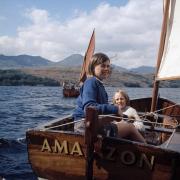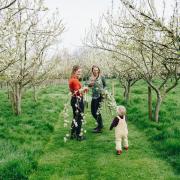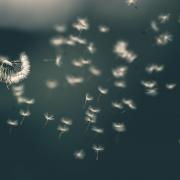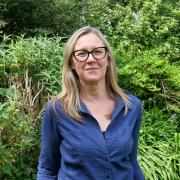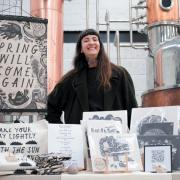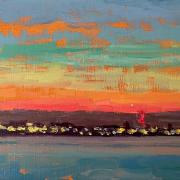Inspired by wildflowers around Hampshire, Lisa Gardner embarked on a journey of discovery to help save endangered species
‘I have always loved nature,’ enthuses Lisa Gardner. ‘The entire ethos of my work is inspired by the natural world; it’s the seed that allows my paintings to grow. I adore wildflowers - they represent the yin and yang of being wild and free, they are strong yet delicate.’
Last summer the 41-year-old set off on a journey, collaborating with the charity Plantlife – as their first artist in residence and supported by the Arts Council to highlight vulnerable species on the edge of extinction. ‘I wanted to learn more about these species and how my art could not only raise awareness but give it more depth in terms of what I really wanted to say. As an artist, it's been a discovery. I have found my creative voice and now I want to speak up for these incredible plants.’

Lisa feels fortunate she has found her passion, but a few years ago realised she was painting more for other people. ‘I was commercially quite successful, painting pictures that I knew would sell, but I wasn't painting for myself anymore. I had desires to paint big, more abstract and more raw, emotionally and fluid.’
So, from May to July last year, she travelled around the UK, from the road verges of Kent to the rugged coast of the Highlands on a wildflower treasure hunt. Scotland would hold special memories with its ‘symphony of colours’. ‘You had to work to find the rare species among this incredible palette. At one point, I had to lean right over a cliffside to spot the tiniest deep pink Scottish Primrose (Purple Oxytropis). It was the way it grew. It has these long arms reaching off the side of the cliff, towards the sky; the flowers reminded me of someone holding a fistful of jewels.’
She describes it as a meeting with the wildflowers; and admits she openly chats to them while painting. ‘It was the most wonderful afternoon of hearing the sea, feeling the wind and being present with this wonderful flower, just me and it. Not only was it a lovely painting moment, but also a personal moment and reminded me of how much of a privilege it was to go on this wildflower journey.’

Seeing the benefit of how art can work with conservation, the charity is looking at incorporating future projects. ‘They can see how the arts can bring that emotional thread that can help connect people in a different way,’ says Lisa. But it is her personal journey that has proved the most surprising. ‘With every new site, my confidence grew and my connection to nature deepened.
‘I have always loved nature, but what I realised is I've been walking through it. By sitting and being present, one layer at a time is revealed to you. The more you sit there, the more you see and sense and the wildlife comes out. It’s life and death happening constantly. Something will be rising and something will be returning. I found that bluebells that had gone over were so much more beautiful. They had this elegance in how they were bowing their heads and slowly returning to earth. There is an elegance in decay.
‘Personally, it has helped me accept things about myself. You see the flaws in nature and it's always purposeful. You'll see something that is a bit broken or damaged, but actually it's beautiful, and it needs to happen so it can rise again next season and blossom. There are so many lessons you can take from that.’

Lisa works under the pseudonym Iris Hill, a tribute to her nan, but her love of art came from both her grandparents. She has vivid memories of time spent drawing with them in Wickham with the aroma of fresh bread from the next-door bakery, which they ran. ‘It’s a nice way of keeping my grandparent’s memory alive.'
After studying photography, she worked in the fashion industry assisting with shots for some big studios in London. She began sketching in her spare time and rediscovered her love of watercolour.
‘It gave me a real creative release; being able to sit down and spend time in quite a meditative way. A lot of my work is not necessarily about it looking a particular way, it's more the process of actually using the paints and seeing how the paint directs itself across the page. I often think of myself as more of a conductor than a painter.’

She set up a studio in Winchester three years ago and works not only with watercolour but natural pigments, including oak gall which is responsibly foraged, finding the process another way to connect with nature.
‘The colours will change and transition over a period of time. I have paintings that have been hanging in the woods for a month, painted soley with natural pigments. I wanted the elements to add their touch – frost, wind the rain. I felt it was inviting nature to make its mark and very freeing as an artist to embrace those flaws – I call them beautiful oppsies. As an artist it was the most wonderful way to create something.’
A London show in January, Fragile Nature, documented her journey, she is also continuing to work with Plantlife documenting pasqueflowers and has created an online six-part wildflower painting course. Lisa continues to find inspiration nearer to home visiting Hoe Road Memorial Meadow in Bishops Waltham which is near to her Southampton home. Through her experience, she has learnt that the canvas is her way of communicating with the world. ‘I don't need to stand up and talk, I can do it through my art,’ she says.

‘A wildflower on the brink of extinction communicates a mix of hope and despair. In the complexity of life the message is simple, the fragility and strength of this moment is all we have. Life is so demanding and hectic, but when we allow ourselves to get comfortable with nature it can become a soothing balm.
‘I’m now ready to open a new chapter and I cannot wait for my art to fill up those pages.’





